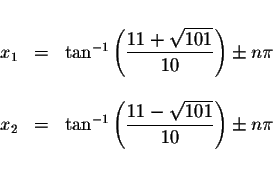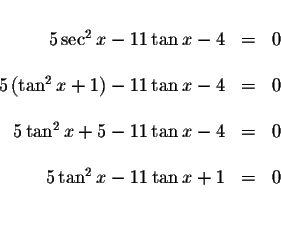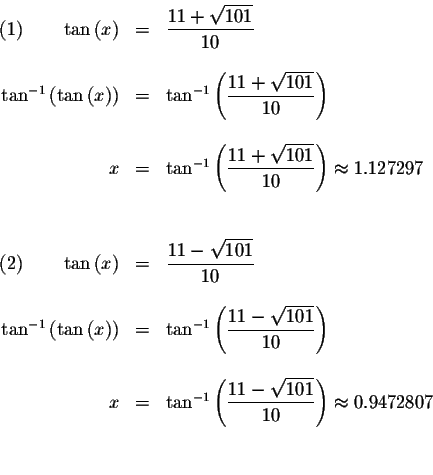
 SOLVING TRIGONOMETRIC EQUATIONS
SOLVING TRIGONOMETRIC EQUATIONS

Note: If you would like a review of trigonometry, click on trigonometry.
Problem 9.7d: Solve for x in the equation
Answer: The exact answers are

where n is an integer.
The approximate values of these solutions are

Solution:
There are an infinite number of solutions to this problem.
In the equation
![]() there are two different
trigonometric terms. To simplify the solution, convert the equation to an
equivalent equation with like trigonometric terms. Which trigonometric term
shall it be? Use the identity
there are two different
trigonometric terms. To simplify the solution, convert the equation to an
equivalent equation with like trigonometric terms. Which trigonometric term
shall it be? Use the identity
![]() to convert the secant term to a tangent term. Substitute
to convert the secant term to a tangent term. Substitute
![]() for
for
![]() in the original
equation.
in the original
equation.


To solve for x, we must first isolate the x? How do we do that? We could
take the ![]() of both sides. However, the tangent function is not
a one-to-one function.
of both sides. However, the tangent function is not
a one-to-one function.
We could restrict the domain of the function so it is one-to-one on the
restricted domain while preserving the original range. The tangent
function is one-to-one on the interval
 .
If we restrict the domain of the tangent function to that interval , we can take the arctangent of both sides of each equation.
.
If we restrict the domain of the tangent function to that interval , we can take the arctangent of both sides of each equation.

Since the period of ![]() equals
equals ![]() ,
these solutions will repeat
every
,
these solutions will repeat
every ![]() units. The exact solutions are
units. The exact solutions are

where n is an integer.
The approximate values of these solutions are

where n is an integer.
You can check each solution algebraically by substituting each solution in the original equation. If, after the substitution, the left side of the original equation equals the right side of the original equation, the solution is valid.
You can also check the solutions graphically by graphing the function formed by the left side of the original equation and graphing the function formed by the right side of the original equation. The x-coordinates of the points of intersection are the solutions. The right side of the equation is 0 and <tex2htmlcommentmark> f(x)=0 is the x-axis. So really what you are looking for are the x-intercepts to the function formed by the left side of the equation.
Algebraic Check:
Check solution

Left Side:
Right Side: ![]()
Since the left side of the original equation equals the right side of the original equation when you substitute 1.127297 for x, then 1.127297 is a solution.
Check solution

Left Side:
Right Side: ![]()
Since the left side of the original equation equals the right side of the original equation when you substitute 0.0947281 for x, then 0.0947281 is a solution.
The exact solutions
 and these solutions repeat every
and these solutions repeat every ![]() units. The approximate values
of these solutions are
units. The approximate values
of these solutions are
![]() and 1.127297 and these
solutions repeat every
and 1.127297 and these
solutions repeat every
![]() units.
units.
Graphical Check:
Graph the equation
![]() Note that the graph
crosses the x-axis many times indicating many solutions.
Note that the graph
crosses the x-axis many times indicating many solutions.
Verify the graph crosses the x-axis at 1.127297. Since the period is
![]() ,
the graph also crosses the x-axis again at
<tex2htmlcommentmark>
1.127297+3.14159265=4.26888965 and at
,
the graph also crosses the x-axis again at
<tex2htmlcommentmark>
1.127297+3.14159265=4.26888965 and at
![]() ,
etc.
,
etc.
The graph crosses the x-axis at
![]() .
Since the period is
.
Since the period is
![]() ,
the graph also crosses the x-axis again at
<tex2htmlcommentmark>
0.0947281+3.14159265=3.2363208 and at
,
the graph also crosses the x-axis again at
<tex2htmlcommentmark>
0.0947281+3.14159265=3.2363208 and at
![]() ,
etc.
,
etc.
Note: If the problem were to find the solutions in the interval
![]() ,
then you choose those solutions from the set of infinite
solutions that belong to the set
,
then you choose those solutions from the set of infinite
solutions that belong to the set
![]()
![]() 1.127297, 3.2363208 and
1.127297, 3.2363208 and
![]()
If you would like to review the solution to another problem, click Back to Solutions and then click on the word solution opposite the problem you want to review.
If you would like to go to the next section, click on Next.
If you would like to go back to the previous section, click on previous.
If you would like to go back to the equation table of contents, click on Contents.

